Development Methodology/Scenario 2: Ethics Assignment ITC506
VerifiedAdded on 2021/04/17
|7
|2087
|45
Homework Assignment
AI Summary
This assignment analyzes an ethical dilemma within a development project, focusing on a scenario where a developer interacts directly with a client regarding project modifications without informing the project director. The solution applies the Doing Ethics Technique (DET) to dissect the situation, identifying facts, non-ethical and ethical issues, and stakeholders involved. It explores the implications of the developer's actions, considering potential violations of the agreement and the impact on the company and client. The assignment then evaluates various options for addressing the situation, such as the project director's involvement in client communications, and the consequences of each. The best option is chosen and justified based on maintaining transparency, ensuring client satisfaction, and adhering to the project's contractual terms. The solution incorporates multiple references to support its arguments.
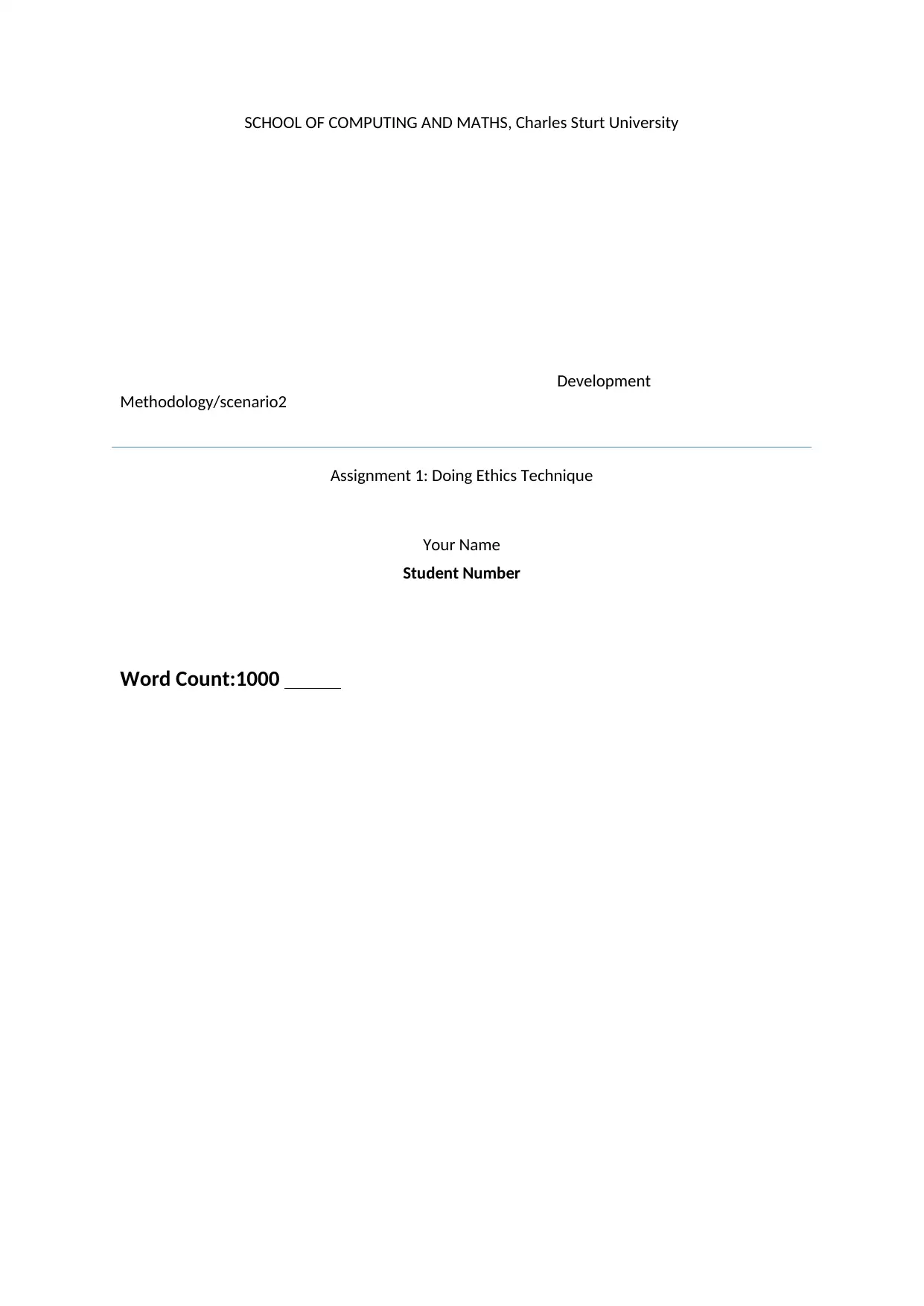
SCHOOL OF COMPUTING AND MATHS, Charles Sturt University
Development
Methodology/scenario2
Assignment 1: Doing Ethics Technique
Your Name
Student Number
Word Count:1000
Development
Methodology/scenario2
Assignment 1: Doing Ethics Technique
Your Name
Student Number
Word Count:1000
Paraphrase This Document
Need a fresh take? Get an instant paraphrase of this document with our AI Paraphraser
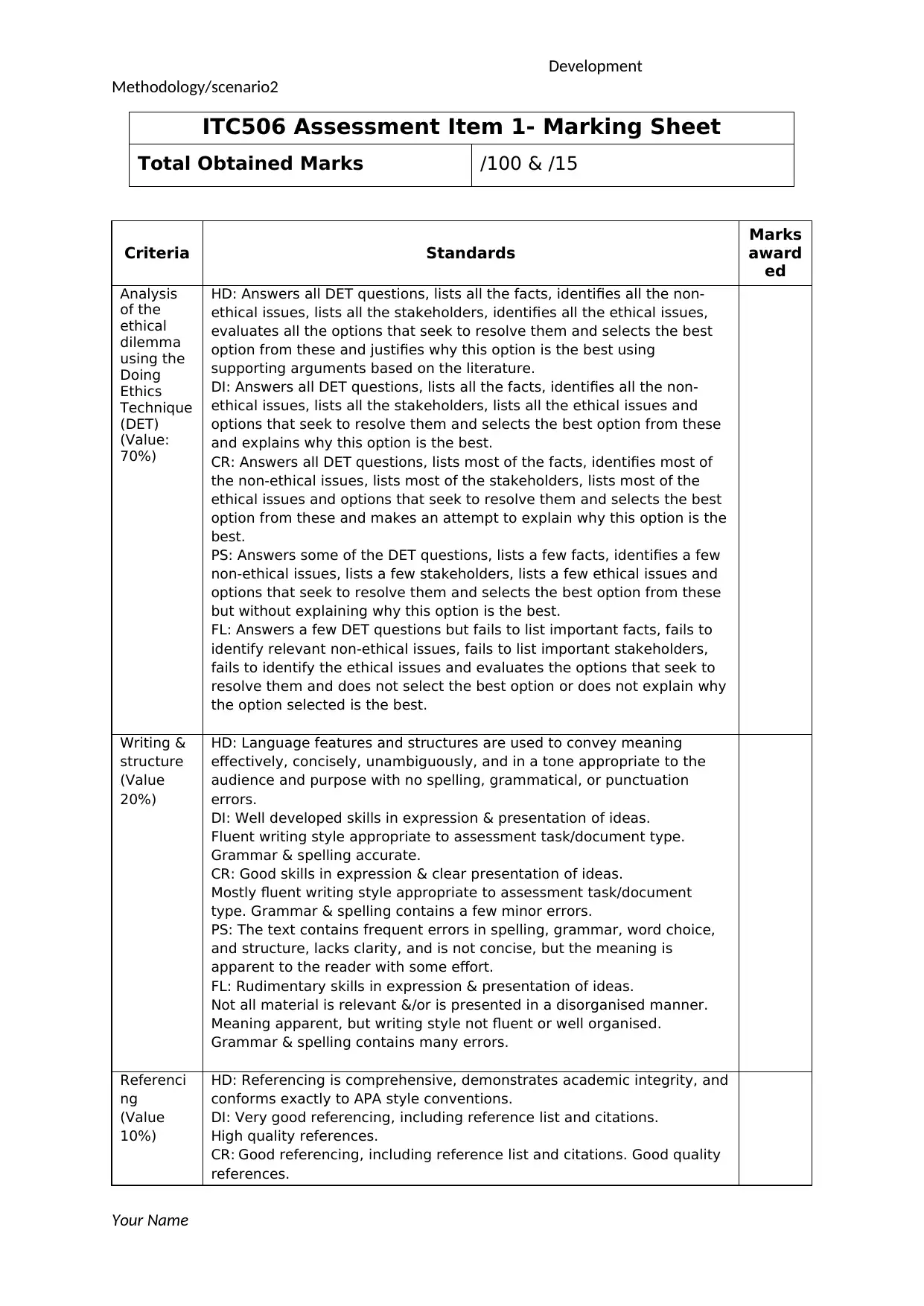
Development
Methodology/scenario2
ITC506 Assessment Item 1- Marking Sheet
Total Obtained Marks /100 & /15
Criteria Standards
Marks
award
ed
Analysis
of the
ethical
dilemma
using the
Doing
Ethics
Technique
(DET)
(Value:
70%)
HD: Answers all DET questions, lists all the facts, identifies all the non-
ethical issues, lists all the stakeholders, identifies all the ethical issues,
evaluates all the options that seek to resolve them and selects the best
option from these and justifies why this option is the best using
supporting arguments based on the literature.
DI: Answers all DET questions, lists all the facts, identifies all the non-
ethical issues, lists all the stakeholders, lists all the ethical issues and
options that seek to resolve them and selects the best option from these
and explains why this option is the best.
CR: Answers all DET questions, lists most of the facts, identifies most of
the non-ethical issues, lists most of the stakeholders, lists most of the
ethical issues and options that seek to resolve them and selects the best
option from these and makes an attempt to explain why this option is the
best.
PS: Answers some of the DET questions, lists a few facts, identifies a few
non-ethical issues, lists a few stakeholders, lists a few ethical issues and
options that seek to resolve them and selects the best option from these
but without explaining why this option is the best.
FL: Answers a few DET questions but fails to list important facts, fails to
identify relevant non-ethical issues, fails to list important stakeholders,
fails to identify the ethical issues and evaluates the options that seek to
resolve them and does not select the best option or does not explain why
the option selected is the best.
Writing &
structure
(Value
20%)
HD: Language features and structures are used to convey meaning
effectively, concisely, unambiguously, and in a tone appropriate to the
audience and purpose with no spelling, grammatical, or punctuation
errors.
DI: Well developed skills in expression & presentation of ideas.
Fluent writing style appropriate to assessment task/document type.
Grammar & spelling accurate.
CR: Good skills in expression & clear presentation of ideas.
Mostly fluent writing style appropriate to assessment task/document
type. Grammar & spelling contains a few minor errors.
PS: The text contains frequent errors in spelling, grammar, word choice,
and structure, lacks clarity, and is not concise, but the meaning is
apparent to the reader with some effort.
FL: Rudimentary skills in expression & presentation of ideas.
Not all material is relevant &/or is presented in a disorganised manner.
Meaning apparent, but writing style not fluent or well organised.
Grammar & spelling contains many errors.
Referenci
ng
(Value
10%)
HD: Referencing is comprehensive, demonstrates academic integrity, and
conforms exactly to APA style conventions.
DI: Very good referencing, including reference list and citations.
High quality references.
CR: Good referencing, including reference list and citations. Good quality
references.
Your Name
Methodology/scenario2
ITC506 Assessment Item 1- Marking Sheet
Total Obtained Marks /100 & /15
Criteria Standards
Marks
award
ed
Analysis
of the
ethical
dilemma
using the
Doing
Ethics
Technique
(DET)
(Value:
70%)
HD: Answers all DET questions, lists all the facts, identifies all the non-
ethical issues, lists all the stakeholders, identifies all the ethical issues,
evaluates all the options that seek to resolve them and selects the best
option from these and justifies why this option is the best using
supporting arguments based on the literature.
DI: Answers all DET questions, lists all the facts, identifies all the non-
ethical issues, lists all the stakeholders, lists all the ethical issues and
options that seek to resolve them and selects the best option from these
and explains why this option is the best.
CR: Answers all DET questions, lists most of the facts, identifies most of
the non-ethical issues, lists most of the stakeholders, lists most of the
ethical issues and options that seek to resolve them and selects the best
option from these and makes an attempt to explain why this option is the
best.
PS: Answers some of the DET questions, lists a few facts, identifies a few
non-ethical issues, lists a few stakeholders, lists a few ethical issues and
options that seek to resolve them and selects the best option from these
but without explaining why this option is the best.
FL: Answers a few DET questions but fails to list important facts, fails to
identify relevant non-ethical issues, fails to list important stakeholders,
fails to identify the ethical issues and evaluates the options that seek to
resolve them and does not select the best option or does not explain why
the option selected is the best.
Writing &
structure
(Value
20%)
HD: Language features and structures are used to convey meaning
effectively, concisely, unambiguously, and in a tone appropriate to the
audience and purpose with no spelling, grammatical, or punctuation
errors.
DI: Well developed skills in expression & presentation of ideas.
Fluent writing style appropriate to assessment task/document type.
Grammar & spelling accurate.
CR: Good skills in expression & clear presentation of ideas.
Mostly fluent writing style appropriate to assessment task/document
type. Grammar & spelling contains a few minor errors.
PS: The text contains frequent errors in spelling, grammar, word choice,
and structure, lacks clarity, and is not concise, but the meaning is
apparent to the reader with some effort.
FL: Rudimentary skills in expression & presentation of ideas.
Not all material is relevant &/or is presented in a disorganised manner.
Meaning apparent, but writing style not fluent or well organised.
Grammar & spelling contains many errors.
Referenci
ng
(Value
10%)
HD: Referencing is comprehensive, demonstrates academic integrity, and
conforms exactly to APA style conventions.
DI: Very good referencing, including reference list and citations.
High quality references.
CR: Good referencing, including reference list and citations. Good quality
references.
Your Name
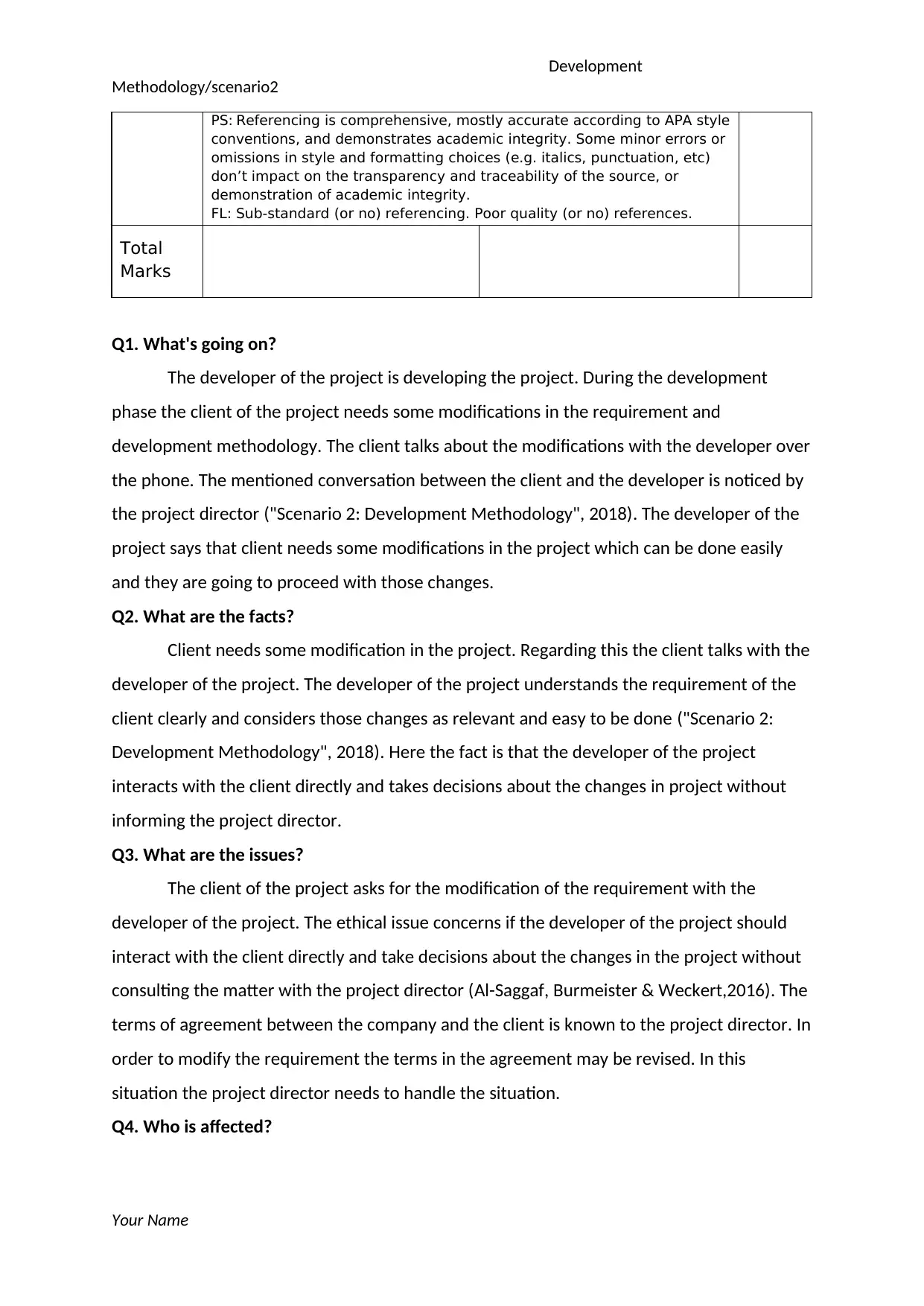
Development
Methodology/scenario2
PS: Referencing is comprehensive, mostly accurate according to APA style
conventions, and demonstrates academic integrity. Some minor errors or
omissions in style and formatting choices (e.g. italics, punctuation, etc)
don’t impact on the transparency and traceability of the source, or
demonstration of academic integrity.
FL: Sub-standard (or no) referencing. Poor quality (or no) references.
Total
Marks
Q1. What's going on?
The developer of the project is developing the project. During the development
phase the client of the project needs some modifications in the requirement and
development methodology. The client talks about the modifications with the developer over
the phone. The mentioned conversation between the client and the developer is noticed by
the project director ("Scenario 2: Development Methodology", 2018). The developer of the
project says that client needs some modifications in the project which can be done easily
and they are going to proceed with those changes.
Q2. What are the facts?
Client needs some modification in the project. Regarding this the client talks with the
developer of the project. The developer of the project understands the requirement of the
client clearly and considers those changes as relevant and easy to be done ("Scenario 2:
Development Methodology", 2018). Here the fact is that the developer of the project
interacts with the client directly and takes decisions about the changes in project without
informing the project director.
Q3. What are the issues?
The client of the project asks for the modification of the requirement with the
developer of the project. The ethical issue concerns if the developer of the project should
interact with the client directly and take decisions about the changes in the project without
consulting the matter with the project director (Al-Saggaf, Burmeister & Weckert,2016). The
terms of agreement between the company and the client is known to the project director. In
order to modify the requirement the terms in the agreement may be revised. In this
situation the project director needs to handle the situation.
Q4. Who is affected?
Your Name
Methodology/scenario2
PS: Referencing is comprehensive, mostly accurate according to APA style
conventions, and demonstrates academic integrity. Some minor errors or
omissions in style and formatting choices (e.g. italics, punctuation, etc)
don’t impact on the transparency and traceability of the source, or
demonstration of academic integrity.
FL: Sub-standard (or no) referencing. Poor quality (or no) references.
Total
Marks
Q1. What's going on?
The developer of the project is developing the project. During the development
phase the client of the project needs some modifications in the requirement and
development methodology. The client talks about the modifications with the developer over
the phone. The mentioned conversation between the client and the developer is noticed by
the project director ("Scenario 2: Development Methodology", 2018). The developer of the
project says that client needs some modifications in the project which can be done easily
and they are going to proceed with those changes.
Q2. What are the facts?
Client needs some modification in the project. Regarding this the client talks with the
developer of the project. The developer of the project understands the requirement of the
client clearly and considers those changes as relevant and easy to be done ("Scenario 2:
Development Methodology", 2018). Here the fact is that the developer of the project
interacts with the client directly and takes decisions about the changes in project without
informing the project director.
Q3. What are the issues?
The client of the project asks for the modification of the requirement with the
developer of the project. The ethical issue concerns if the developer of the project should
interact with the client directly and take decisions about the changes in the project without
consulting the matter with the project director (Al-Saggaf, Burmeister & Weckert,2016). The
terms of agreement between the company and the client is known to the project director. In
order to modify the requirement the terms in the agreement may be revised. In this
situation the project director needs to handle the situation.
Q4. Who is affected?
Your Name
⊘ This is a preview!⊘
Do you want full access?
Subscribe today to unlock all pages.

Trusted by 1+ million students worldwide
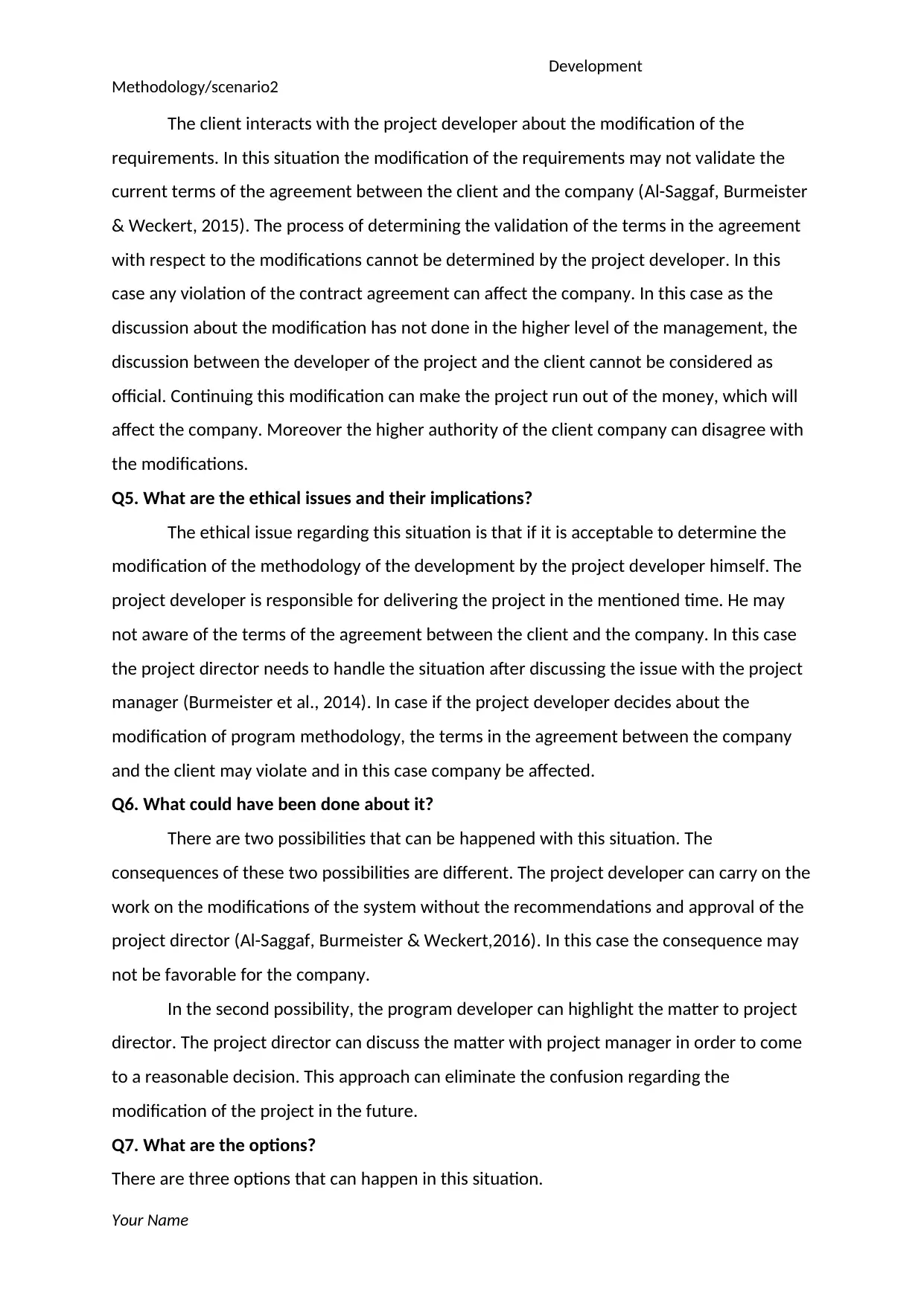
Development
Methodology/scenario2
The client interacts with the project developer about the modification of the
requirements. In this situation the modification of the requirements may not validate the
current terms of the agreement between the client and the company (Al-Saggaf, Burmeister
& Weckert, 2015). The process of determining the validation of the terms in the agreement
with respect to the modifications cannot be determined by the project developer. In this
case any violation of the contract agreement can affect the company. In this case as the
discussion about the modification has not done in the higher level of the management, the
discussion between the developer of the project and the client cannot be considered as
official. Continuing this modification can make the project run out of the money, which will
affect the company. Moreover the higher authority of the client company can disagree with
the modifications.
Q5. What are the ethical issues and their implications?
The ethical issue regarding this situation is that if it is acceptable to determine the
modification of the methodology of the development by the project developer himself. The
project developer is responsible for delivering the project in the mentioned time. He may
not aware of the terms of the agreement between the client and the company. In this case
the project director needs to handle the situation after discussing the issue with the project
manager (Burmeister et al., 2014). In case if the project developer decides about the
modification of program methodology, the terms in the agreement between the company
and the client may violate and in this case company be affected.
Q6. What could have been done about it?
There are two possibilities that can be happened with this situation. The
consequences of these two possibilities are different. The project developer can carry on the
work on the modifications of the system without the recommendations and approval of the
project director (Al-Saggaf, Burmeister & Weckert,2016). In this case the consequence may
not be favorable for the company.
In the second possibility, the program developer can highlight the matter to project
director. The project director can discuss the matter with project manager in order to come
to a reasonable decision. This approach can eliminate the confusion regarding the
modification of the project in the future.
Q7. What are the options?
There are three options that can happen in this situation.
Your Name
Methodology/scenario2
The client interacts with the project developer about the modification of the
requirements. In this situation the modification of the requirements may not validate the
current terms of the agreement between the client and the company (Al-Saggaf, Burmeister
& Weckert, 2015). The process of determining the validation of the terms in the agreement
with respect to the modifications cannot be determined by the project developer. In this
case any violation of the contract agreement can affect the company. In this case as the
discussion about the modification has not done in the higher level of the management, the
discussion between the developer of the project and the client cannot be considered as
official. Continuing this modification can make the project run out of the money, which will
affect the company. Moreover the higher authority of the client company can disagree with
the modifications.
Q5. What are the ethical issues and their implications?
The ethical issue regarding this situation is that if it is acceptable to determine the
modification of the methodology of the development by the project developer himself. The
project developer is responsible for delivering the project in the mentioned time. He may
not aware of the terms of the agreement between the client and the company. In this case
the project director needs to handle the situation after discussing the issue with the project
manager (Burmeister et al., 2014). In case if the project developer decides about the
modification of program methodology, the terms in the agreement between the company
and the client may violate and in this case company be affected.
Q6. What could have been done about it?
There are two possibilities that can be happened with this situation. The
consequences of these two possibilities are different. The project developer can carry on the
work on the modifications of the system without the recommendations and approval of the
project director (Al-Saggaf, Burmeister & Weckert,2016). In this case the consequence may
not be favorable for the company.
In the second possibility, the program developer can highlight the matter to project
director. The project director can discuss the matter with project manager in order to come
to a reasonable decision. This approach can eliminate the confusion regarding the
modification of the project in the future.
Q7. What are the options?
There are three options that can happen in this situation.
Your Name
Paraphrase This Document
Need a fresh take? Get an instant paraphrase of this document with our AI Paraphraser
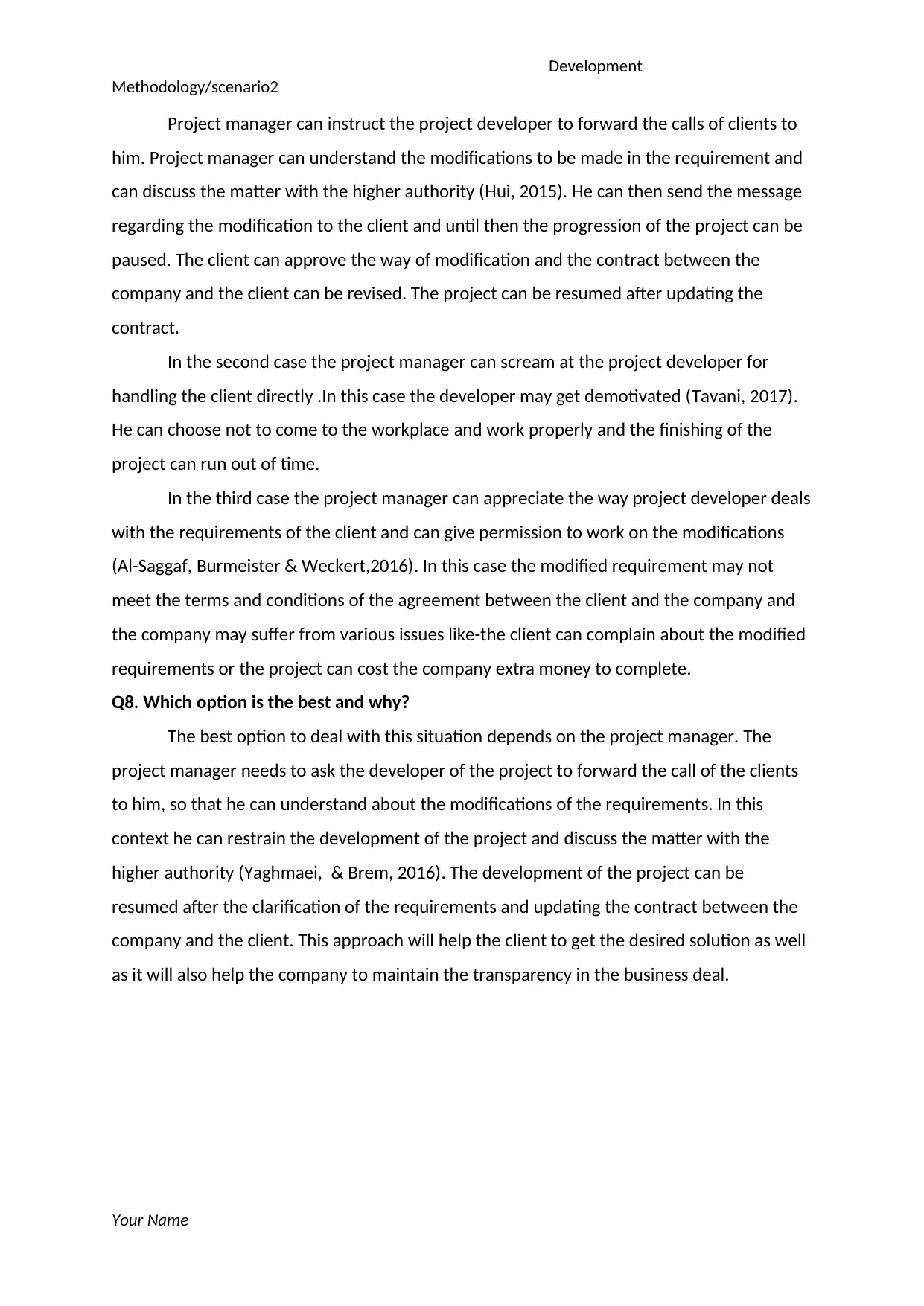
Development
Methodology/scenario2
Project manager can instruct the project developer to forward the calls of clients to
him. Project manager can understand the modifications to be made in the requirement and
can discuss the matter with the higher authority (Hui, 2015). He can then send the message
regarding the modification to the client and until then the progression of the project can be
paused. The client can approve the way of modification and the contract between the
company and the client can be revised. The project can be resumed after updating the
contract.
In the second case the project manager can scream at the project developer for
handling the client directly .In this case the developer may get demotivated (Tavani, 2017).
He can choose not to come to the workplace and work properly and the finishing of the
project can run out of time.
In the third case the project manager can appreciate the way project developer deals
with the requirements of the client and can give permission to work on the modifications
(Al-Saggaf, Burmeister & Weckert,2016). In this case the modified requirement may not
meet the terms and conditions of the agreement between the client and the company and
the company may suffer from various issues like-the client can complain about the modified
requirements or the project can cost the company extra money to complete.
Q8. Which option is the best and why?
The best option to deal with this situation depends on the project manager. The
project manager needs to ask the developer of the project to forward the call of the clients
to him, so that he can understand about the modifications of the requirements. In this
context he can restrain the development of the project and discuss the matter with the
higher authority (Yaghmaei, & Brem, 2016). The development of the project can be
resumed after the clarification of the requirements and updating the contract between the
company and the client. This approach will help the client to get the desired solution as well
as it will also help the company to maintain the transparency in the business deal.
Your Name
Methodology/scenario2
Project manager can instruct the project developer to forward the calls of clients to
him. Project manager can understand the modifications to be made in the requirement and
can discuss the matter with the higher authority (Hui, 2015). He can then send the message
regarding the modification to the client and until then the progression of the project can be
paused. The client can approve the way of modification and the contract between the
company and the client can be revised. The project can be resumed after updating the
contract.
In the second case the project manager can scream at the project developer for
handling the client directly .In this case the developer may get demotivated (Tavani, 2017).
He can choose not to come to the workplace and work properly and the finishing of the
project can run out of time.
In the third case the project manager can appreciate the way project developer deals
with the requirements of the client and can give permission to work on the modifications
(Al-Saggaf, Burmeister & Weckert,2016). In this case the modified requirement may not
meet the terms and conditions of the agreement between the client and the company and
the company may suffer from various issues like-the client can complain about the modified
requirements or the project can cost the company extra money to complete.
Q8. Which option is the best and why?
The best option to deal with this situation depends on the project manager. The
project manager needs to ask the developer of the project to forward the call of the clients
to him, so that he can understand about the modifications of the requirements. In this
context he can restrain the development of the project and discuss the matter with the
higher authority (Yaghmaei, & Brem, 2016). The development of the project can be
resumed after the clarification of the requirements and updating the contract between the
company and the client. This approach will help the client to get the desired solution as well
as it will also help the company to maintain the transparency in the business deal.
Your Name
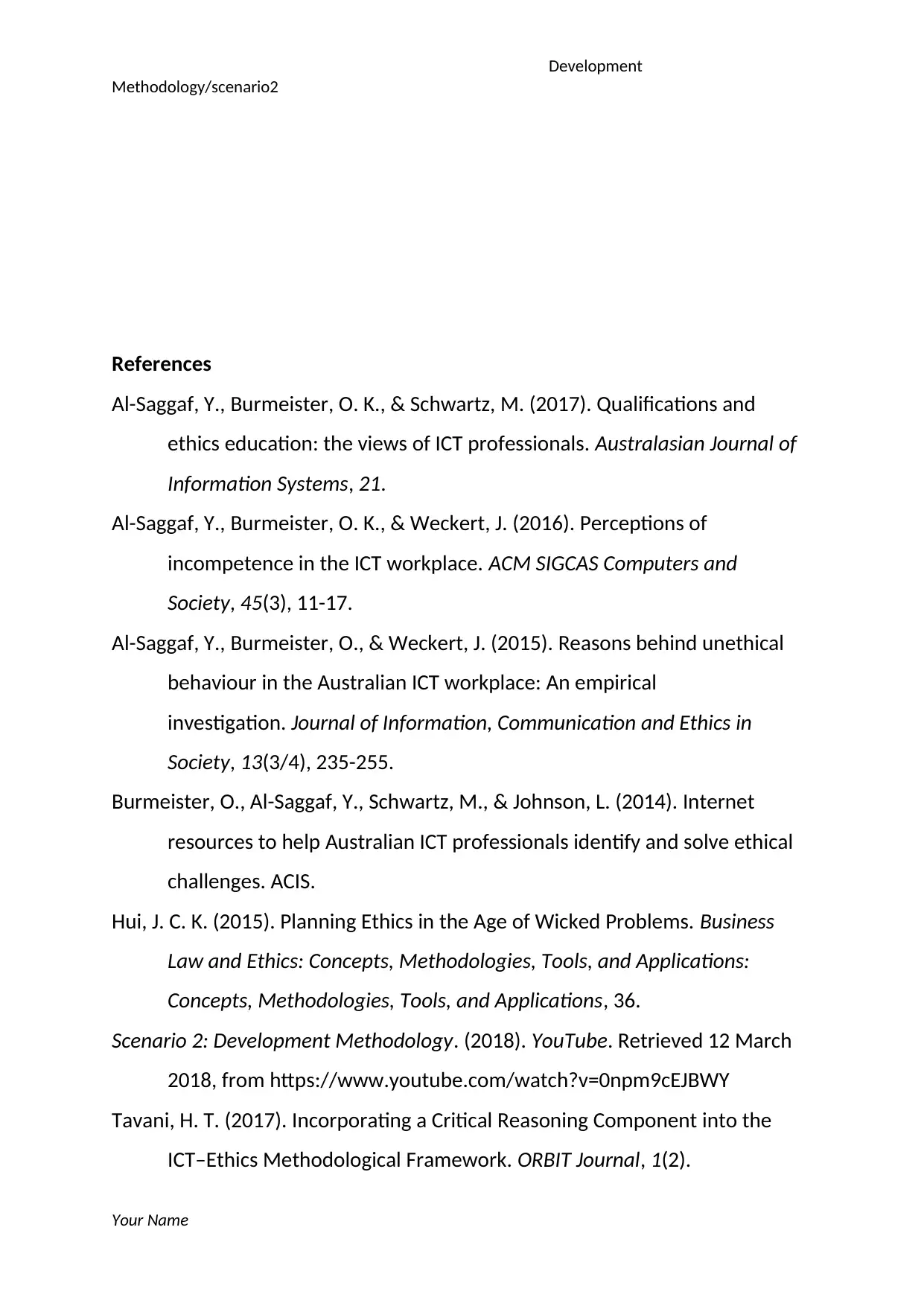
Development
Methodology/scenario2
References
Al-Saggaf, Y., Burmeister, O. K., & Schwartz, M. (2017). Qualifications and
ethics education: the views of ICT professionals. Australasian Journal of
Information Systems, 21.
Al-Saggaf, Y., Burmeister, O. K., & Weckert, J. (2016). Perceptions of
incompetence in the ICT workplace. ACM SIGCAS Computers and
Society, 45(3), 11-17.
Al-Saggaf, Y., Burmeister, O., & Weckert, J. (2015). Reasons behind unethical
behaviour in the Australian ICT workplace: An empirical
investigation. Journal of Information, Communication and Ethics in
Society, 13(3/4), 235-255.
Burmeister, O., Al-Saggaf, Y., Schwartz, M., & Johnson, L. (2014). Internet
resources to help Australian ICT professionals identify and solve ethical
challenges. ACIS.
Hui, J. C. K. (2015). Planning Ethics in the Age of Wicked Problems. Business
Law and Ethics: Concepts, Methodologies, Tools, and Applications:
Concepts, Methodologies, Tools, and Applications, 36.
Scenario 2: Development Methodology. (2018). YouTube. Retrieved 12 March
2018, from https://www.youtube.com/watch?v=0npm9cEJBWY
Tavani, H. T. (2017). Incorporating a Critical Reasoning Component into the
ICT–Ethics Methodological Framework. ORBIT Journal, 1(2).
Your Name
Methodology/scenario2
References
Al-Saggaf, Y., Burmeister, O. K., & Schwartz, M. (2017). Qualifications and
ethics education: the views of ICT professionals. Australasian Journal of
Information Systems, 21.
Al-Saggaf, Y., Burmeister, O. K., & Weckert, J. (2016). Perceptions of
incompetence in the ICT workplace. ACM SIGCAS Computers and
Society, 45(3), 11-17.
Al-Saggaf, Y., Burmeister, O., & Weckert, J. (2015). Reasons behind unethical
behaviour in the Australian ICT workplace: An empirical
investigation. Journal of Information, Communication and Ethics in
Society, 13(3/4), 235-255.
Burmeister, O., Al-Saggaf, Y., Schwartz, M., & Johnson, L. (2014). Internet
resources to help Australian ICT professionals identify and solve ethical
challenges. ACIS.
Hui, J. C. K. (2015). Planning Ethics in the Age of Wicked Problems. Business
Law and Ethics: Concepts, Methodologies, Tools, and Applications:
Concepts, Methodologies, Tools, and Applications, 36.
Scenario 2: Development Methodology. (2018). YouTube. Retrieved 12 March
2018, from https://www.youtube.com/watch?v=0npm9cEJBWY
Tavani, H. T. (2017). Incorporating a Critical Reasoning Component into the
ICT–Ethics Methodological Framework. ORBIT Journal, 1(2).
Your Name
⊘ This is a preview!⊘
Do you want full access?
Subscribe today to unlock all pages.

Trusted by 1+ million students worldwide
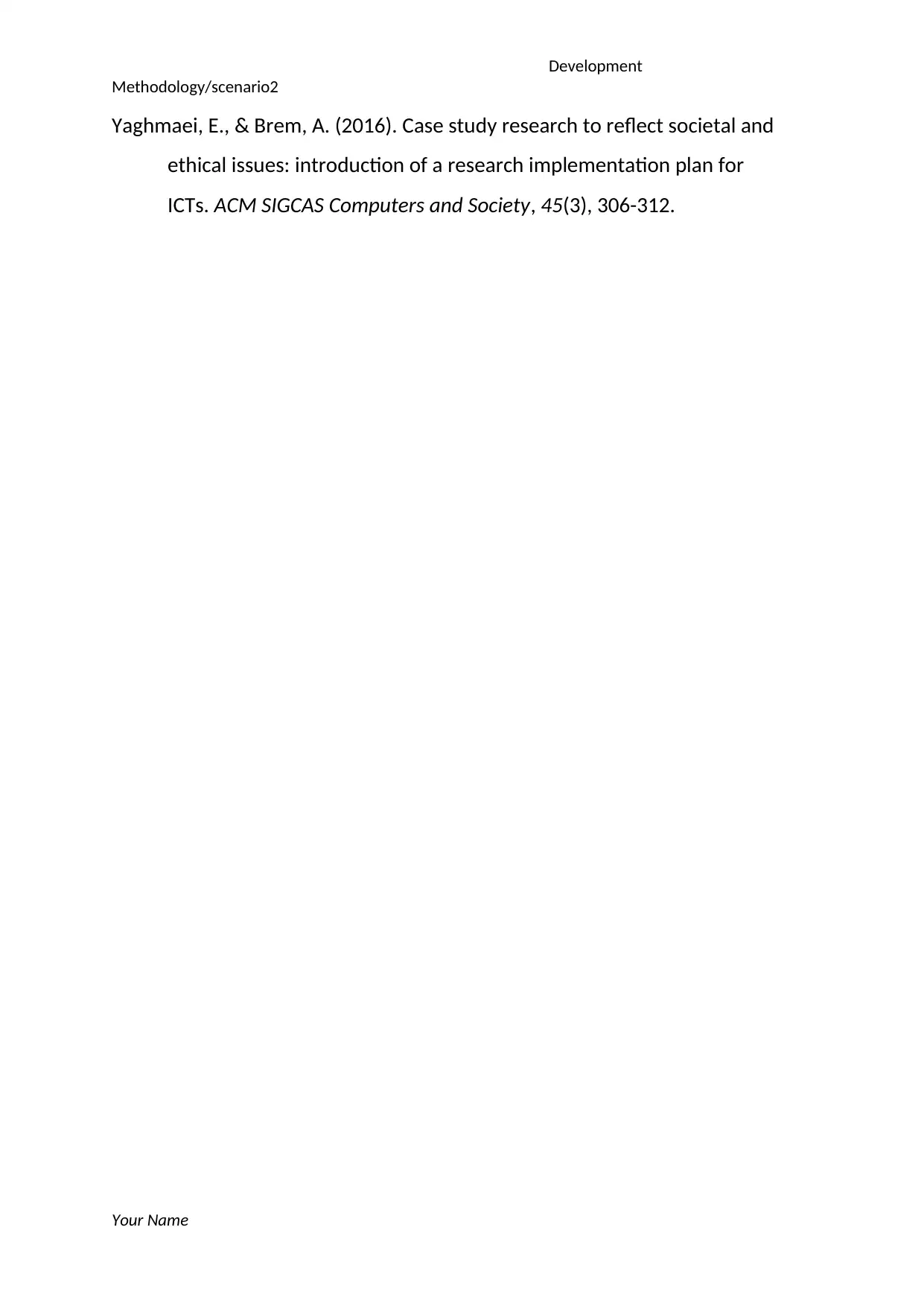
Development
Methodology/scenario2
Yaghmaei, E., & Brem, A. (2016). Case study research to reflect societal and
ethical issues: introduction of a research implementation plan for
ICTs. ACM SIGCAS Computers and Society, 45(3), 306-312.
Your Name
Methodology/scenario2
Yaghmaei, E., & Brem, A. (2016). Case study research to reflect societal and
ethical issues: introduction of a research implementation plan for
ICTs. ACM SIGCAS Computers and Society, 45(3), 306-312.
Your Name
1 out of 7
Related Documents
Your All-in-One AI-Powered Toolkit for Academic Success.
+13062052269
info@desklib.com
Available 24*7 on WhatsApp / Email
![[object Object]](/_next/static/media/star-bottom.7253800d.svg)
Unlock your academic potential
Copyright © 2020–2025 A2Z Services. All Rights Reserved. Developed and managed by ZUCOL.





